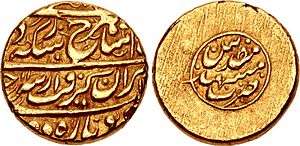Shahrokh Shah
| Shahrokh Shah شاهرخ | |
|---|---|
 Coin minted during the reign of Shahrokh Shah. | |
| Shah of the Afsharid dynasty | |
| Reign | October 1748–January 1750 |
| Predecessor | Ebrahim Shah |
| Successor | Suleiman II (Safavid pretender) |
| Shah of the Afsharid dynasty | |
| Reign | March 1750–1796 |
| Predecessor | Suleiman II |
| Successor | Agha Mohammad Shah (Qajar conquest) |
| Born |
21 March 1734 Mashhad |
| Died |
1796 (aged 62) Damghan |
| Spouse | Goharshah Khanum |
| Issue |
Nader Mirza Afshar Nasr Allah Mirza Abbas Mirza Afshar Qahraman mirza Imam Quli Mirza Yazdan Baksh Mirza Reza Quli Mirza Goharshad Begum Shahzanan Begum Gulrukh Begum Zinat Shah Begum |
| Father | Reza Qoli Mirza Afshar |
| Mother | Fatimeh Sultan Begum |
| Religion | Twelver Shia Islam |
Shahrokh Mirza Afshar, better known by his dynastic name of Shahrokh Shah (Persian: شاهرخ: also spelled Shah Rokh) (c. 1734–1796), was a king of the Afsharid dynasty and a contemporary of the Zand kings.
Origin
Shahrokh Mirza was the son of Reza Qoli Mirza Afshar, who was the son of the powerful Iranian shah Nader Shah (r. 1736-1747), who had briefly carved what was arguably the most powerful empire at the time. Shahrokh's mother was the Safavid princess Fatimeh Sultan Begum, who was the daughter of the Safavid shah Sultan Husayn (r. 1694–1722), thus making Shahrokh part of the Safavid royal family.
Reign
Shahrokh was elected by the nobles following the assassination of Ebrahim Afshar in 1748. Shahrokh's son Nader Mirza Afshar, became the prince of Khorasan. Shahrokh made Mashhad the capital of his kingdom. He was a contemporary of Mirza Mohammad, who was the son of shah Suleiman I's daughter and a clergyman.[1] Encouraged by the nobles, he came to believe he was the true heir to the throne. Thus he captured and blinded Shahrokh capitalizing on the popular dissatisfaction with Shahrokh's rule, partly owing to the conduct of his Georgian favorite Rasul Beg, who scandalized Mashhad by making free with the harem of his master.[2] In 1749, during a struggle for power, the son of the Khan of Tabriz, Azad Khan Afghan, began a campaign for independence which removed the province of Azerbaijan from Iran, while in the west the Qajar tribe led by Mohammad Hassan Khan took over the region of Mazandaran.
In 1750, Soleyman II was captured and blinded by the followers of Shahrokh, subsequent to which Shahrokh was reinstated as Shah.
In 1760, when Karim Khan took control of Iran, he did not try to depose Shahrokh out of respect for Nader; however, the realm of Shahrokh was reduced to the province of Khorasan.
When the Qajar ruler Agha Mohammad Shah reached Mashhad, Shahrokh, along with a prominent mujtahid named Mirza Mahdi, went to the Qajar encampment. There they were warmly received by Agha Mohammad Shah's nephew Hossein Qoli Khan.[3] Shortly afterwards, Agha Mohammad Shah sent a force of 8,000 soldiers under Suleiman Khan Qajar, followed by Mirza Mahdi, to conquer Mashhad and affirm its citizens of the Shah's generosity. A day later, Agha Mohammad Shah, followed the customary of the famous Iranian shah Abbas I the Great, and entered Mashhad by foot as a pilgrim to the Imam Reza shrine, whilst being teary eyed and kissing the ground. His pilgrimage continued for 23 days, where he seemed to be unaware of the politics of the country.[3]
However, things quickly instantly changed after that—Agha Mohammad Shah ordered the digging up of Nader Shah's corpse, and had it sent to Tehran, where it was reburied alongside Karim Khan Zand's corpse. He then forced Shahrokh to give any riches that originally belonged to Nader Shah.[3] Shahrokh vowed that he did not possess any more of Nader Shah's riches. Agha Mohammad Shah, ruthless and revengeful, and with an desire for treasures, disbelieved him, and had him hurt severely to confess the hidden locations of the last gems that he had passed down to him from his grandfather—Shahrokh, however, refused to speak.[4] However, he eventually confessed the locations of the gems. Shahrokh was sent to Mazandaran with his family, but died at Damghan due to the injuries he had suffered by his torturers.
References
- ↑ http://irane-man.tripod.com/NaderShah.html
- ↑ Lang, David Marshall (1957), The Last Years of the Georgian Monarchy, 1658-1832, p. 148. Columbia University Press
- 1 2 3 Hambly 1991, p. 130.
- ↑ Axworthy 2009, p. 144.
Sources
- Perry, John (1991). "The Zand dynasty". The Cambridge History of Iran, Vol. 7: From Nadir Shah to the Islamic Republic. Cambridge: Cambridge University Press. pp. 1–63. ISBN 9780521200950.
- Perry, John R. (1983). "Abu'l-Fath Khan Bakhtiari". Encyclopaedia Iranica, Vol. I, Fasc. 3. p. 285.
- Hambly, Gavin R.G (1991). "Agha Muhammad Khan and the establishment of the Qajar dynasty". The Cambridge History of Iran, Vol. 7: From Nadir Shah to the Islamic Republic. Cambridge: Cambridge University Press. pp. 104–144. ISBN 9780521200950.
| Regnal titles | ||
|---|---|---|
| Preceded by Ebrahim Shah Afshar |
Shah of Persia (1st time) 1748–1749 |
Succeeded by Suleiman II of Persia |
| Preceded by Suleiman II of Persia |
Shah of Persia (2nd time) 1750–1760 |
Succeeded by Karim Khan Zand |
| Preceded by Ebrahim Shah Afshar |
Azerbaijan (as part of Persia) 1748–1749 |
Succeeded by Azad Khan Afghan |
| Preceded by Ebrahim Shah Afshar |
Ruler of Mazandaran (as part of Persia) 1748–1749 |
Succeeded by Mohammad Hasan Khan Qajar |
| Preceded by Soleyman II Safavi |
Ruler of Khorasan 1750–1796 |
Succeeded by Agha Mohammad Khan Qajar |